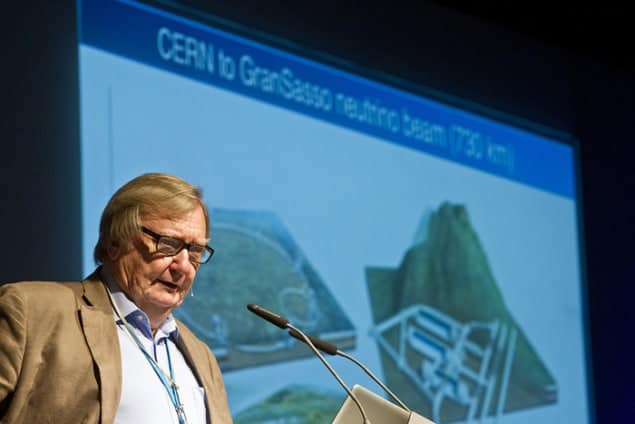
CERN’s discovery of a new fundamental particle – most likely a Higgs boson – was barely hours old when physicists speaking at this year’s Lindau Nobel Laureate Meeting in Germany argued the case for a new facility to measure its properties in detail. Speaking out in favour of a new machine was former CERN boss Carlo Rubbia, who shared the 1984 Nobel Prize for Physics for the discovery of the W and Z bosons. “The technology is there to construct a Higgs factory,” he claimed. “You don’t need €10bn; it could be done relatively cheaply.”
Rubbia is regarded as the “godfather” of the Large Hadron Collider (LHC), having pushed hard for the development of the machine in the 1980s, and was instrumental in adapting CERN’s previous flagship accelerator – the Super Proton Synchrotron – into a collider capable of producing W and Z bosons. Speaking at Lindau, he argued that physicists should follow the same approach that was adopted then: follow up the discovery in detail with a cleaner lepton collider. In the case of the W and Z, this was the Large Electron–Positron (LEP) collider that previously occupied the 27 km-long tunnel that now houses the LHC.
Currently, the facility tabled to follow the LHC is a linear electron–positron collider tens of kilometres long with a price tag of £10–20bn. But now that the mass of CERN’s new particle has been established – roughly 125 GeV – physicists have a clearer idea of what sort of machine they need to build in order to pin down its properties and measure its interactions with other particles. That work would be vital in establishing whether the particle is the Higgs boson predicted by the Standard Model or something more exotic that opens the door to a deeper theory of elementary particles.
The technology is there to construct a Higgs factory. You don’t need €10bn; it could be done relatively cheaply Former CERN boss Carlo Rubbia
“The question is whether the LHC will do it all, or whether there is a need for another facility,” said Rubbia. “With a Higgs of 125 GeV we need only a modest machine, perhaps not a large linear collider.” Rubbia points out that muons colliding at a combined energy of roughly 125 GeV would suffice – just over half the energy of LEP and requiring a machine with a much smaller radius.
Like electrons, muons are point particles that produce much cleaner collisions than protons, which would allow Higgs-like particles to be studied with far less background noise than is generated by proton collisions. Being 200 times heavier than electrons, muons lose considerably less energy via synchrotron radiation when travelling in a circular collider and their collisions would produce Higgs bosons in much greater quantities.
Cool questions
The big challenge in building a muon collider is how to “cool” the muons so that they can be funnelled into narrow beams that can be accelerated. However, muon-cooling technology is already being investigated at several institutions, including the UK’s Rutherford Appleton Laboratory, while Fermilab in the US has its own dedicated programme to develop a muon collider, which would also allow intense beams of neutrinos to be fired underground at detectors on the other side of the Earth to further understand how neutrinos oscillate between their three flavours.
One physicist who shares Rubbia’s vision is David Gross from the Kavli Institute for Theoretical Physics in Santa Barbara, US, who shared the 2004 Nobel Prize for Physics for his work on asymptotic freedom. “A muon collider is a great idea,” he told delegates in Lindau, “and one that the US should take the lead on.”
Speaking via a live video link to the Lindau meeting from CERN, theorist John Ellis of King’s College London agreed that the discovery of the new boson puts a Higgs factory on the agenda, but thinks it is premature to fix ideas. “We need to see what else the LHC will find, after a couple of years of high-energy running,” he said. “It would be better to have a facility that wasn’t just limited to a Higgs factory.”



